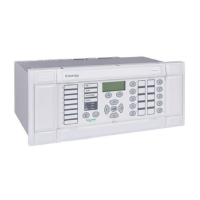Commissioning P54x/EN CM/La4
MiCOM P543, P544, P545 & P546
CM) 10-7
CM
1. INTRODUCTION
The P54x employs a high degree of self-checking and, in the unlikely event of a failure, will
give an alarm. As a result of this, the commissioning tests do not need to be as extensive as
with non-numeric electronic or electro-mechanical relays.
To commission numeric relays, it is only necessary to verify that the hardware is functioning
correctly and the application-specific software settings have been applied to the relay. It is
considered unnecessary to test every function of the relay if the settings have been verified
by one of the following methods:
Extracting the settings applied to the relay using appropriate setting software (preferred
method)
Via the operator interface
Unless previously agreed to the contrary, the customer will be responsible for determining
the application-specific settings to be applied to the relay and for testing of any scheme logic
applied by external wiring and/or configuration of the relay’s internal programmable scheme
logic.
Blank commissioning test and setting records are provided at the end of this chapter for
completion as required.
As the relay’s menu language is user-selectable, it is acceptable for the Commissioning
Engineer to change it to allow accurate testing as long as the menu is restored to the
customer’s preferred language on completion.
To simplify the specifying of menu cell locations in these Commissioning Instructions, they
will be given in the form [courier reference: COLUMN HEADING, Cell Text]. For example,
the cell for selecting the menu language (first cell under the column heading) is located in the
System Data column (column 00) so it would be given as [0001: SYSTEM DATA,
Language].
Before carrying out any work on the equipment, the user should be familiar with the
contents of the Safety Guide (SFTY/4L M/H11) or later issue, or the Safety and
Technical Data chapters of this Technical Manual and also the ratings on the
equipment’s rating label.
The MiCOM P54x relay must not be disassembled in any way during commissioning.

